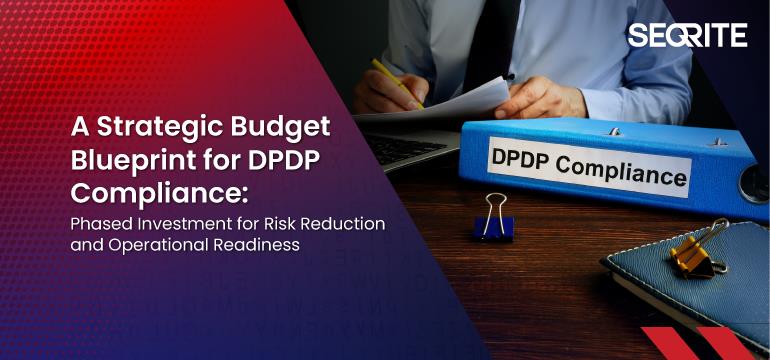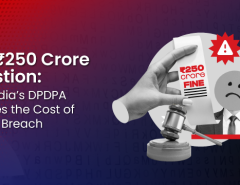India’s Digital Personal Data Protection (DPDP) Act represents a significant regulatory shift that affects every Data Fiduciary handling the personal data of Indian Data Principals. With penalties reaching ₹250 crore, the Act elevates data protection from a routine compliance requirement to a core component of enterprise risk management.
To meet these obligations effectively and sustainably, organizations must adopt a structured budgeting approach. The appropriate message for boards and senior leadership is straightforward: start small, but start now. Early, targeted investment reduces high-severity exposure, establishes operational foundations, and avoids the cost and disruption associated with reactive compliance programs.
1. The Case for Early Budget Allocation
DPDP compliance involves interdependent activities across technology, legal, and operational domains. Core requirements—consent management, purpose limitation, retention and erasure workflows, rights fulfilment, and mandatory security safeguards—cannot be implemented in isolation. They depend on baseline capabilities such as accurate data inventories, governance structures, and system visibility.
Deferring investment increases:
- Regulatory exposure, especially in security and rights fulfilment;
- Operational strain, as manual compliance becomes unsustainable;
- Future costs, due to rushed implementation or retrofitting.
A phased budget structure enables the organization to mitigate critical risks early on while distributing capital expenditures in a predictable and defensible manner.
2. The Need for an Integrated CISO–DPO Budget
DPDP dissolves the boundary between privacy and security investments. Technical safeguards—such as logging, encryption, access controls, and monitoring—are now legal requirements. Operational obligations—such as consent, retention, erasure, and grievance handling—depend on accurate and timely data management, supported by secure systems.
An integrated CISO–DPO budget ensures that:
- foundational capabilities (e.g., data discovery, classification) are funded once, not twice;
- security technologies directly support regulatory outcomes;
- budget requests align with enterprise-level risk reduction rather than departmental needs;
- evidence generation (logs, reports, audit trails) meets both security and regulatory scrutiny.
This unified approach strengthens the overall compliance posture and improves budget efficiency.
3. Phased Budget Framework for DPDP Compliance
A staged investment roadmap provides clear milestones for the board, ensuring readiness before penalties or obligations take effect.
Phase I (0–6 Months): Foundational Visibility and Governance
Initial investments should focus on building the minimum baseline needed for all future DPDP activities.
Budget Priorities:
- Data discovery, classification, and mapping
- Establishing the DPO function, governance committees, and policies
- Training to build organizational awareness and mitigate human-factor risk
- Identifying and onboarding critical privacy management tools
Strategic Rationale:
Without visibility into what personal data exists, where it resides, and why it is processed, it is impossible to implement consent, fulfill rights, minimize data, or delete it. Phase I enables all subsequent compliance activities.
Phase II (6–12 Months): Operationalising DPDP Requirements
This phase focuses on capabilities that directly influence DPDP’s highest-impact compliance areas.
Budget Priorities:
- Consent Management Platform for capturing and tracking verifiable, granular consent
- Automated workflows for Data Principal rights and grievance redressal
- Retention schedules and automated erasure workflows
- Operational dashboards for consent, rights request SLAs, and processing transparency
Strategic Rationale:
These investments address requirements tied to significant penalties, including ₹200 crore for consent-related failures and ₹50 crore for gaps in grievance and rights fulfillment. Operational readiness in this phase protects the organization from predictable and recurring compliance exposure.
Phase III (12–18+ Months): Continuous Assurance and Security Maturity
Long-term compliance depends on sustained visibility, strong security controls, and audit-ready evidence.
Budget Priorities:
- Encryption, access controls, and continuous logging and monitoring
- Breach detection tools, response playbooks, notification processes
- Third-party risk assessments and contractual updates
- DPIAs, independent audits, and controls required for Significant Data Fiduciaries
Strategic Rationale:
The most significant exposure under DPDP—₹250 crore for security breaches—is mitigated by robust controls and rapid detection and response. This phase builds resilience and ensures the organization can consistently demonstrate compliance.
4. Quantifying Financial Exposure to Support Budget Approval
Boards prioritise investments supported by financial reasoning. DPDP-aligned budgeting should quantify:
- Maximum Loss Exposure (MLE): financial impact of potential fines
- Operational cost of non-compliance: breach response, investigations, delays
- Cost inefficiencies: manual rights handling, ad hoc reporting, slow discovery
- Risk reduction per rupee spent: using quantitative risk frameworks such as FAIR
This framing enables the board to evaluate DPDP investments not as compliance costs but as measurable reductions in enterprise risk.
5. Demonstrating Tangible Return on Investment
DPDP compliance investments generate value across multiple dimensions.
Operational ROI:
Automation decreases manual workload in rights fulfilment, consent tracking, investigations, and audit preparation. This improves SLA adherence and reduces error risk.
Risk Mitigation ROI:
Investments directly reduce exposure to high-severity penalties and breach-related costs, reinforcing resilience across security and privacy functions.
Strategic ROI:
Demonstrable compliance enhances trust, improves customer confidence, and positions the organization favourably with partners and regulators.
These outcomes collectively justify both initial and ongoing budget allocations.
6. Strategic Directive for the Board
DPDP compliance necessitates a multi-phase investment strategy, but it does not require disproportionate or front-loaded capital expenditures. The critical success factor is the timely initiation of foundational work, followed by structured scaling aligned with risk priority and regulatory timelines.
The recommended directive is clear: begin with targeted foundational investments, expand capabilities in phases, and commit to sustained assurance. Start small, but start now.
This approach ensures cost efficiency, reduces regulatory exposure, and establishes the organization as a responsible Data Fiduciary prepared for India’s evolving data governance landscape.
Empower your CISO and DPO with a unified, scalable DPDP compliance framework. Connect with Seqrite to get started.




